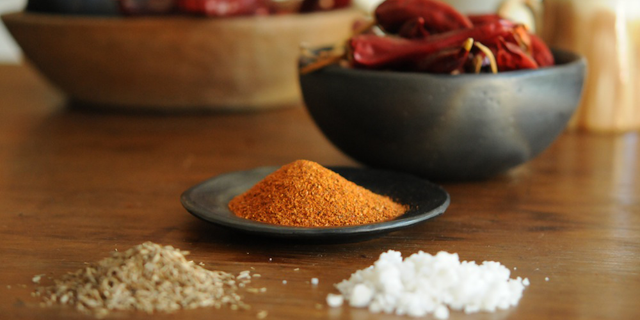There’s a delicious, nose-tingling smoky aroma at the stall at the Vega, Santiago, Chile’s main fresh market. Amid hanging strings of finger-long dark red cacho de cabra (goat’s horn peppers), there are piles of small bags of coarse-ground, brick-red powder, and a stream of customers stopping to make a purchase.
These magical bags hold a serving of merquén (or merkén), a spice blend unique to Chile. This blend emphasizes the rich, earthy taste of the peppers, picked green in late summer and sundried to a dark leathery red before they are smoked and crushed with salt, cilantro seeds, and sometimes oregano, or cumin. The result of this smoking and crushing is a spice that triggers a sneeze in the sensitive, but sits lightly on the palate. Not excessively hot, salty, nutty, and spicy, this pepper make it's presence known, though is nowhere near as assertive as Mexico’s chipotle.
Merquén comes from the gastronomy of the Mapuche, an indigenous people living partly in the south of Chile. The main Mapuche population center is in the country’s Región de la Araucania, about ten hours south of Santiago. The spice mix has mainly been used in flavoring cheeses and nuts, and can be found in tostadurías (dry good shops) all over the country. It's also found in many dishes from snacks to entrees: you can buy maní al merquén (roasted peanuts dusted with merquén), taste it in puré (mashed potatoes); and find it in the traditional southern Chilean dish, papas con mote, a comfort food stew of boiled potatoes cooked with wheat berries and seasoned with onions. Newly, it’s being used as a spice rub on many different kinds of meat and seafood, including octopus.
Merquén is also turning up as a twist on the traditional Chilean aperitif, the pisco sour. A sprinkle on top of the cocktail glass is enough to delight. And it has become a Chilean twist on the Mexican michelada, where merquén replaces Tabasco sauce to help liven up a pale beer. Merquén is also at by-the-slice pizza restaurants in Santiago (where at home you might find a shaker of crushed red pepper). The spice also surprises some patrons on popcorn in bars, a huge departure from how Chileans normally eat their cabritas, which is sweet.
But it’s not just drinks and savory dishes that feature merquén. Chocolatiers are using the spice, sometimes combined with cinnamon, to brighten up their dark chocolates, and it occasionally shows up in ice cream, making a smooth counterpoint to merquén’s light bite.
While in Chile, you can buy merquén at the markets, in the supermarket or specialty spice shops, most people in the US will probably have to stick to online shopping to get their fix. Two brands, Origen and Etnia, export to the United States, with distributors including Amazon and Tu Chile Aquí. Or keep your eye out for food fairs where merquén sometimes makes an appearance, if you're lucky.


![Making Mealtime Matter with La Familia: Easy Sofrito [Video]](https://thelatinkitchen.com/wp-content/uploads/2015/10/sofrito-shutterstock__0-500x383.jpg)
![Easy Latin Smoothies: Goji Berry Smoothie [Video]](https://thelatinkitchen.com/wp-content/uploads/2015/12/goji_berry-shutterstock_-500x383.jpg)
















![Fun and Fast Recipes: Fiesta Cabbage Salad [Video]](https://thelatinkitchen.com/wp-content/uploads/2015/11/fiesta_cabbage_slaw-shutterstock_-500x383.jpg)









